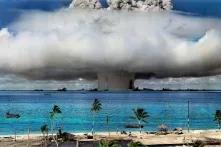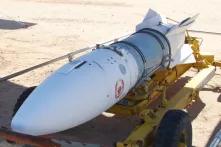Benetick Kabua Maddison of the Marshallese Educational Initiative (MEI) explains the history of nuclear testing in the Marshall Islands. Connecting it with the colonial legacy, climate change and the Marshallese pathway of seeking compensation from the US Government.

In the late 1940s, the United States characterized my homelands as tiny and scattered islands with a small, expendable population when they needed a territory for nuclear tests for the “good of all mankind” and for “world peace.” The U.S. acquisition of the atomic bomb and its testing on colonized ground gave rise to the United States as a superpower and fueled the Cold War and nuclear arms race. Recently, my homelands have loomed large in U.S. national security debates due to the perceived threats by China in the Pacific region. This year marks the expiration of the Compact of Free Association, an agreement between the United States and the Republic of the Marshall Islands (RMI) governments originally signed in 1986, partly to mitigate the damages inflicted on Marshallese bodies and lands from U.S. nuclear testing. The U.S. conducted 67 high-yield nuclear tests in the Marshall Islands from 1946-1958, the biological, ecological and cultural consequences of which are ongoing.
During a U.S. Congressional hearing in July 2023 in which RMI negotiator Jack Ading made his case for higher compensation, U.S. Compact negotiator Joseph Yun insisted that there was no more money. Even members of Congress, who had recently pushed the Biden Administration to apologize to the Marshallese people for testing on their lands, pressured the RMI government to sign the Compact. These events are the most recent example of how a small, financially dependent nation struggles to obtain nuclear justice while being exposed to a powerful, nuclear-armed state that refuses to accept responsibility for its imperialist actions – the consequences of which impact the day-to-day lives of all Marshallese people. It also shows how international treaties like the Treaty on the Prohibition of Nuclear Weapons (TPNW), which prohibits any state from developing, testing, producing, acquiring, possessing, stockpiling, using, or threatening to use nuclear weapons, may be the best hope for Marshallese people to realize some form of nuclear justice.
Colonial Legacy
To understand how the RMI came to be dominated by the United States, it is important to acknowledge that the U.S. had already drastically altered Marshallese culture in the mid-nineteenth century through the influence of U.S.-based missionaries. The patriarchal Christianization of the country went hand in hand with the later German introduction of capitalism that shifted the balance of power among the traditional ruling class. With Germany’s loss in World War I, Japan took over the Islands under the authority of the League of Nations, the precursor to today’s United Nations (U.N.). The U.S. military then wrested control of the Islands from the Empire of Japan at the end of World War II. After the atomic bombings of Hiroshima and Nagasaki and with the U.S. military occupation of the Marshall Islands, the U.S. quickly identified Bikini as the site of its nuclear testing program. In 1947, the U.N. authorized the U.S. to administer the Marshall Islands as part of the Trust Territory of the Pacific, an agreement allowing the U.S. to conduct its nuclear testing program secretly and on foreign soil.
Nuclear Testing Period and the Disproportionate Effect on Women
When the U.S. military first arrived on Enewetak, a large coral atoll of 40 islands and legislative district of the RMI which would later turn into a second nuclear testing site, it encountered a Marshallese matrilineal society, where women held real power, and land rights were passed down through the mother. Under U.S. occupation, Marshallese women were shut out of the system as U.S. military personnel did not recognize women’s roles in governance. Women bore much of the brunt of the trauma and scars left by years of nuclear testing and radiation exposure. After the 1954 “Bravo” detonation, and for decades thereafter, women experienced miscarriages, thyroid abnormalities that altered their voices, psychological distress, and physical loss of their lands, which is central to Marshallese identity. Children, too, were particularly vulnerable to radiation exposure, with many of the most severely exposed later diagnosed with various cancers, including thyroid cancer and leukemia.
“Bravo” was one thousand times the force of both the first two bombs dropped on the cities of Hiroshima and Nagasaki in Japan, and the first two tests at Bikini, as it was a fifteen-megaton blast. The late Marshallese climate ambassador and nuclear abolitionist, Tony deBrum, was nine years old when he witnessed the “Bravo” event from Likiep, located 452 kilometers southeast of Bikini. “Everything turned red – the ocean, the fish, the sky, and my grandfather’s net,” deBrum described. After the massive exposure of the Marshallese people due to “Bravo,” the international Atomic Energy Commission (AEC) sped up the frequency and intensity of nuclear tests. In the aftermath of “Bravo,” the AEC also started a secret study, Project 4.1, in which Marshallese were used as test subjects to measure the effects of radiation exposure on human beings. Marshallese leaders petitioned the U.N. to instruct the U.S. to relocate communities to safer areas away from Bikini and Enewetak and to end their nuclear testing program in 1954 and 1956, respectively, due to reports of people getting sick from the tests. Their pleas were ignored.
Nuclear Testing and the Climate Crisis: Twin Existential Threats
The U.S. Nuclear Testing Program in the Marshall Islands ended in 1958. However, the health, environmental, and cultural consequences still exist. Marshallese continue to suffer from numerous cancers. The displacement of populations and the destruction of ancestral lands meant people needed to depend on imported food, shifting the population from a stable, traditional diet to an unhealthy one made up of processed foods that contribute to diabetes, heart disease, and hypertension.
As part of the attempted U.S. cleanup of the island Runit, part of the Enewetak atoll, in 1977, U.S. service members bulldozed tons of nuclear waste inside an existing bomb crater. Even contaminated material from Nevada was shipped to Enewetak, dumped in the crater, and capped with an eighteen-inch-thick concrete dome. However, the structure lacked a secure foundation to contain the deadly contaminants from seeping into the lagoon. Even though Columbia University’s K=1 Project studies show that Runit Dome contains lethal amounts of plutonium, uranium, and the radioisotope strontium 90, the U.S. assessed the dome in 2020 and reported that the structure is safe. Marshallese have repeatedly asked the U.S. government to address the cracked structure leaking waste into the fragile environment, including the threat that climate change and rising seas pose to the RMI, but the U.S. ignored them – again.
The RMI is a nuclear-affected community on the frontline of the climate crisis. The highest elevation of the country sits at two meters above sea level. As a low-lying atoll nation, my homelands risk disappearing this century. Floods, droughts, and storms have become more extreme. The climate crisis exacerbated the existing health and environmental issues from the nuclear testing program. The humanitarian and socio-economic costs of the nuclear legacy and the climate crisis are insurmountable for a nation without the financial means to mitigate these existential threats.
Forced Migration
Forced migration began in 1946 for nuclear weapons testing and has had unintended but devastating consequences. My grandmother was one of the original Bikinians removed by the U.S. military. She is a clan head for lands on Bikini, yet she has not seen those lands since her removal as a child in 1946. Given my grandmother’s age and the continued danger of exposure at Bikini, she is unlikely ever to see her birthplace again. However, forced migration did not stop after the initial Bikinian displacement. The U.S. military and AEC consistently relocated Marshallese communities and returned them to highly contaminated lands. After the nuclear testing ended, forced relocation continued on Kwajalein, where the U.S. military began testing intercontinental ballistic missiles in an ever-increasing testing zone.
Compact Realities
In 1986, the original Compact encouraged Marshallese to leave the islands in large numbers for the United States. In the latest RMI Census, the country’s population decreased by 25 percent, and now one-half to two-thirds of the Marshallese population resides outside of the islands, with the majority living in the U.S. In 2001 my family left Majuro for Arkansas. Today, more than twenty thousand Marshallese reside in the region. Those who leave seek employment and access to public education and healthcare – all of which the U.S. was treaty-bound to have provided under the Trust Territory agreement but failed to deliver. Economic challenges, nuclear and environmental issues, and a mediocre infrastructure in the RMI will continue to push people to migrate.
The TPNW and Nuclear Justice
While we will continue to advocate for nuclear justice from the U.S. government, given the willful ignorance and, in some cases, purposeful deception by U.S. officials to cover up the extent of the nuclear damages inflicted upon my people, it is crucial and necessary that we engage with the international community. Marshallese officials have been reluctant to sign or even engage in discussions with TPNW representatives as they insist that the U.S. fulfill its nuclear obligations. RMI Permanent Representative to the U.N., Amatlain Kabua, recently shared that part of the reluctance to sign the TPNW is based on Marshallese beliefs that the U.S. must be held responsible for nuclear damages and that Marshallese are “simply not prepared to accept any treaty or agreement which says otherwise.” This stance stems from a language under Articles 6 and 7 TPNW that specify that each signatory is responsible for the health and well-being of individuals and the maintenance and clean-up of contaminated areas under its jurisdiction. Consequently, it means RMI would be responsible under mentioned articles, instead of the U.S. Government. Though I and other Marshallese activists will continue to share the Marshallese story and engage with global civil society, international officials must recognize the history of broken agreements and shifting interpretations by the dominant world powers at the expense of nations and indigenous peoples worldwide. Their concerns regarding Articles 6 and 7 must be addressed so that nuclear-affected communities are not saddled with costs they cannot bear.


